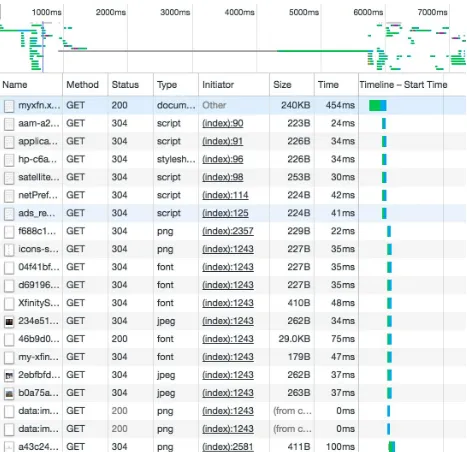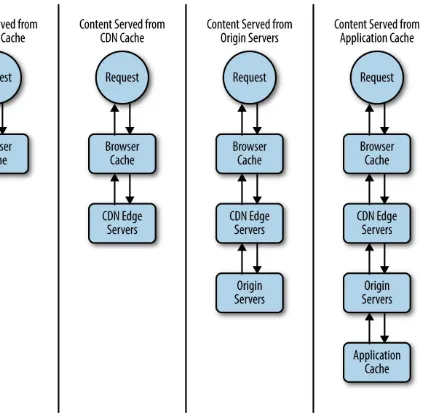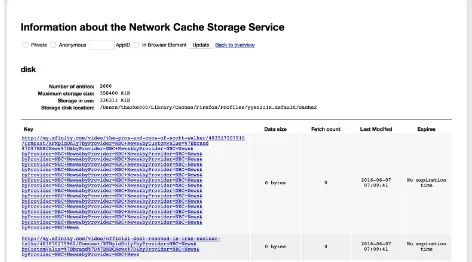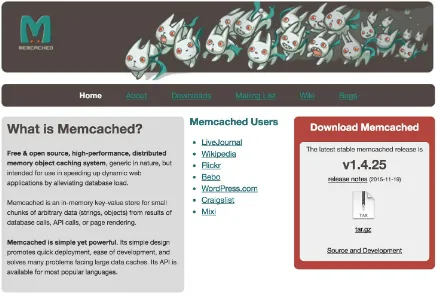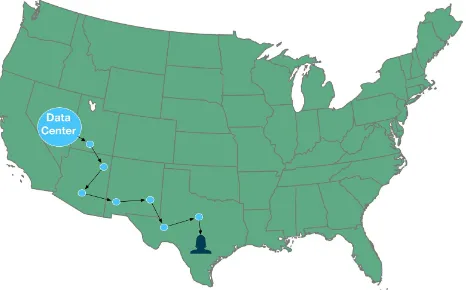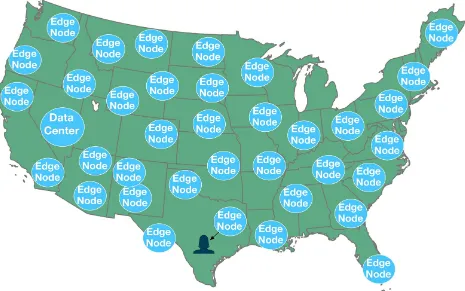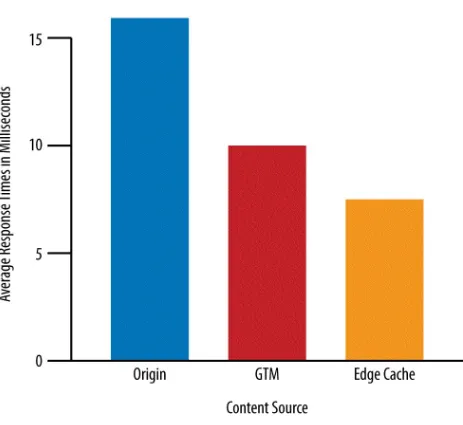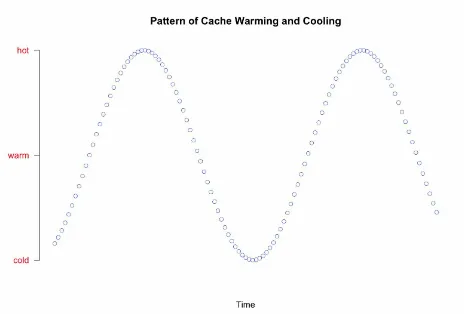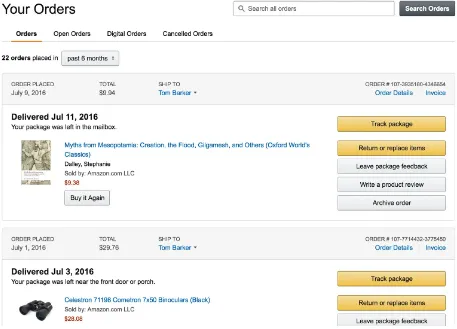Intelligent Caching
Leveraging Cache to Scale at the Frontend
Intelligent Caching
by Tom Barker
Copyright © 2017 O’Reilly Media, Inc. All rights reserved. Printed in the United States of America.
Published by O’Reilly Media, Inc., 1005 Gravenstein Highway North, Sebastopol, CA 95472.
O’Reilly books may be purchased for educational, business, or sales promotional use. Online editions are also available for most titles (http://safaribooksonline.com). For more information, contact our corporate/institutional sales department: 800-998-9938 or
Editors: Brian Anderson and Virginia Wilson
Revision History for the First Edition
2016-12-20: First Release
The O’Reilly logo is a registered trademark of O’Reilly Media, Inc.
Intelligent Caching, the cover image, and related trade dress are trademarks of O’Reilly Media, Inc.
While the publisher and the author have used good faith efforts to ensure that the information and instructions contained in this work are accurate, the publisher and the author disclaim all responsibility for errors or omissions, including without limitation responsibility for damages resulting from the use of or reliance on this work. Use of the information and instructions contained in this work is at your own risk. If any code samples or other technology this work contains or describes is subject to open source licenses or the
intellectual property rights of others, it is your responsibility to ensure that your use thereof complies with such licenses and/or rights.
Preface
The idea for this book started when I came to understand how hard it is to hire engineers and technical leaders to work at scale. By scale I mean having tens of millions of users and hundreds of millions of requests hitting your site. Before I started working on properties on the national stage, these would have been DDOS numbers. At these numbers, HTTP requests start stacking up, and users start getting turned away. At these numbers, objects start to accumulate, and the heap starts to run out of memory in minutes. At these numbers, even just logging can cause your machines to run out of file handles.
Unless you are working or have worked at this scale, you haven’t run into the issues and scenarios that come up when running a web application nationally or globally. To compound the issue, no one was talking about these specific issues; or if they were, they were focusing on different aspects of the
problem. Things like scaling at the backend, resiliency, and virtual machine (VM) tuning are all important topics and get the lion’s share of the coverage. Very few people are actually talking about utilizing cache tiers to scale at the frontend. It was just a learned skill for those of us that had been living and breathing it, which meant it was hard to find that skill in the general
population.
So I set about writing a book that I wish I had when I started working on my projects. As such the goal of this book is not to be inclusive of all facets of the industry, web development, the HTTP specification, or CDN capabilities. It is to simply to share my own learnings and experience on this subject, maybe writing to prepare a future teammate.
What this book is:
A discussion about the principals of scaling on the frontend
A primer on benefits of adding a CDN to your frontend scaling strategy
A reflection of my own experiences, both the benefits that I’ve seen, and issues that I have run into and how I dealt with them
What this book is not:
An exhaustive look at all caching strategies
An in-depth review of CDN capabilities
A representation of every viewpoint in the field
I hope that my experiences are useful and that you are able to learn
Chapter 1. Utilizing Cache to
Offload Scale to the Frontend
Since 2008 I have run, among other things, a site that handles around 500 million page views per month, hundreds of transactions per second, and is on the Alexa Top 50 Sites for the US. I’ve learned how to scale for that level of traffic without incurring a huge infrastructure and operating cost while still maintaining world-class availability. I do this with a small staff that handles new features, in addition to a handful of virtual machines.
What Is Cache?
Cache is a mechanism to store data as responses to future requests to prevent the need to look up and retrieve that data again. When talking about web cache, it is literally the body of a given HTTP response that is indexed and retrieved using a cache key, which is the HTTP method and URI of the request.
Setting Cache
Leveraging cache is as easy as specifying the appropriate headers in the HTTP response. Let’s take a look at what that means.
When you open up your browser and type in the address of a website the browser makes an HTTP request for the resource to the remote host. This request looks something like this:
GET /assets/app.js HTTP/1.1 Host: []
Connection: keep-alive Cache-Control: max-age=0
User-Agent: Mozilla/5.0 (Macintosh; Intel Mac OS X 10_10_4) AppleWebKit/537.36 (KHTML, like Gecko) Chrome/51.0.2704.84 Safari/537.36
Accept: */*
Accept-Encoding: gzip, deflate, sdch Accept-Language: en-US,en;q=0.8
If-Modified-Since: Thu, 09 Jun 2016 02:49:35 GMT
The first line of the request specifies the HTTP method (in this case GET), the URI of the requested resource, and the protocol. The remainder of the lines specify the HTTP request headers that outline all kinds of useful information about the client making the request, like what the browser/OS combination is, what the language preference is, etc.
The web server in turn will issue an HTTP response, and in this scenario, that is what is really interesting to us. The HTTP response will look something like this:
HTTP/1.1 200 OK
Date: Sat, 11 Jun 2016 02:08:40 GMT Server: Apache
Cache-Control: max-age=10800, public, must-revalidate Connection: Keep-Aliv
Keep-Alive: timeout=15, max=98 ETag: "c7c-2268d-534cf78e98dc0"
Generally you will see either a 200 OK for cache misses, a 304 Not Modified with an empty body for cache hits, or a 200 (from cache) for content served from browser cache.
Cache-Control
The most important header for caching is the Cache-Control header. It accepts a comma-delimited string that outlines the specific rules, called
directives, for caching a particular piece of content that must be honored by all caching layers in the transaction. The following are some of the supported cache response directives that are outlined in the HTTP 1.1 specification:
public
This indicates that the response is safe to cache, by any cache, and is shareable between requests. I would set most shared CSS, JavaScript libraries, or images to public.
private
This indicates that the response is only safe to cache at the client, and not at a proxy, and should not be part of a shared cache. I would set personalized content to private, like an API call that returns a user’s shopping cart.
no-cache
This says that the response should not be cached by any cache layer.
no-store
This is for content that legally cannot be stored on any other machine, like a DRM license or a user’s personal or financial information.
no-transform
Some CDNs have features that will transform images at the edge for performance gains, but setting the no-transform directive will tell the cache layer to not alter or transform the response in any way.
must-revalidate
This informs the cache layer that it must revalidate the content after it has reached its expiration date.
This directive is the same as must-revalidate, except it applies only to proxy caches; browser cache can ignore this.
max-age
This specifies the maximum age of the response in seconds.
s-maxage
This directive is for shared caches and will override the max-age directive.
ETag
The ETag header, short for entity tag, is a unique identifier that the server assigns to a resource. It is an opaque identifier, meaning that it is designed to leak no information about what it represents.
When the server responds with an ETag, that ETag is saved by the client and used for conditional GET requests using the If-None-Match HTTP request header. If the ETag matches, then the server responds with a 304 Not Modified status code instead of a 200 OK to let the client know that the cached version of the resource is OK to use.
Figure 1-1. Waterfall chart showing 304s indicating cache results
Vary
The Vary header tells the server what additional request headers to take into consideration when constructing the response. This is useful when specifying cache rules for content that might have the same URI but differs based on user agent or accept-language.
The Pragma and Expires headers are two that were part of the HTTP 1.0 standard. But Pragma has since been replaced in HTTP 1.1 by Cache-Control. Even still, conventional wisdom says that it’s important to
continue to include them for backward compatibility with HTTP 1.0 caches. What I have found is that applications built when HTTP 1.0 was the standard — legacy middleware tiers, APIs, and even proxies — look for these headers and if they are not present do not know how to handle caching.
NOTE
I personally ran into this with one of my own middleware tiers that I had inherited at some point in the past. We were building new components and found during load testing that nothing in the new section we were making was being cached. It took us a while to realize that the internal logic of the code was looking for the Expires header.
Pragma was designed to allow cache directives, much like Cache-Control now does, but has since been deprecated to mainly only specify
no-cache.
Expires specifies a date/time value that indicates the freshness lifetime of a resource. After that date the resource is considered stale. In HTTP 1.1 the
Tiers of Cache
As web developers, we can leverage three main types of cache defined by where along the flow the cache is set:
Browser cache
Proxy cache
Application cache
Figure 1-3. A request traversing different tiers of cache
Browser cache
Browser cache is the fastest cache to retrieve and easiest cache to use. But it is also the one that we have the least amount of control over. Specifically we can’t invalidate browser cache on demand; our users have to clear their own cache. Also certain browsers may choose to ignore rules that specify not to cache content, in favor of their own strategies for offline browsing.
server, it simply pulls the content from the local copy.
As an end user, you can see your browser’s cache and cache settings by
typing about:cache in the location bar. Note this works for most browsers that are not Internet Explorer.
To leverage browser cache, all we need to do is properly set our cache control rules for the content that we want cached.
See Figure 1-4 for how Firefox shows its browser cache stored on disk in its
Figure 1-4. Disk cache in Firefox’s about:cache screen
Proxy cache
Proxy cache is leveraging an intermediate tier to serve as a cache layer. Requests for content will hit this cache layer and be served cached content rather than ever getting to your origin servers.
In Chapter 2 we will discuss combining this concept with a CDN partner to serve edge cache.
Application cache
Application cache is where you implement a cache layer, like memcached, in your application or available to your application that allows you to store API or database calls so that the data from those calls is available without having to make the same calls over and over again. This is generally implemented at the server side and will make your web server respond to requests faster because it doesn’t have to wait for upstream to respond with data.
Summary
Scaling at the backend involves allocating enough physical machines, virtual machines, or just resources to handle large amounts of traffic. This generally means that you have a large infrastructure to monitor and maintain. A node is down, gets introduced to the load balancer, and is seen by the end user as an intermittent error, impacting your site-availability metrics.
Chapter 2. Leveraging a CDN
Browser cache is a great tool, and I would say table stakes for starting to create a frontend, scalable site. But when your traffic and performance goals demand more, it is usually time to step up to partnering with a content
delivery network (CDN). This chapter we look at leveraging a CDN to both improve your performance and offload the number of requests via proxy caching at the edge, called edge caching.
Edge Caching
Edge serving is where a CDN will provide a network of geographically distributed servers that in theory will reduce time to load by moving the serving of the content closer to the end user. This is called edge serving, because the serving of the content has been pushed to the edge of the networks, and the servers that serve the content are sometimes called edge nodes.
To visualize the benefits of edge computing, picture a user who lives in
Texas trying to access your content. Now you don’t yet use a CDN, and all of your content is hosted in your data center in Nevada. In order for your
content to reach your user, it must travel across numerous hops, with each hop adding tens or even hundreds of milliseconds of latency.
Figure 2-1. Content hosted in a data center in Nevada served to an end user in Texas traversing seven theoretical hops
Now say you are leveraging a CDN that has edge nodes across the country. Your origin servers are still your data center, but mirrors of your content are stored on your CDN partner’s hundreds or thousands of edge nodes, and there is an edge node in the same area as your end user. You have eliminated all of the hops and any latency that they would bring. Even if you think of the
packets as light traveling down fiber optics, if light has less distance to travel, it will reach the end user faster.
Figure 2-2. Content served from an edge node in Texas served to the same end user in Texas
Now that your content is served at the edge, make sure your cache rules for your content are set correctly, using the Cache-Control and ETag
headers that we discussed in Chapter 1. Suddenly you have edge caching. Note that in addition to honoring your origin cache settings, your CDN may apply default cache settings for you. When you combine the benefits of both GTM and edge caching, you drastically increase your potential uptime.
LAST KNOWN GOOD
Quantifying the Theory
I leverage edge caching for most of the sites that I run, so I thought it would be fun to quantify this theory with real, live content. To do this, I opened my command line and ran ping against a subset of content on each of my tiers: my data center origins, my origins utilizing just GTM, and finally my content served from the CDN edge cache.
CDN Offload
Besides speeding up delivery of the content to the end user, another big benefit of using a CDN’s edge cache is offloading traffic. Sometimes called
CDN Cache Hit Ratio, this is the amount of traffic, both total bandwidth and sheer number of transactions, that can be handled by the cache nodes versus the number that gets passed back to your origin servers.
The ratio is calculated by dividing the total number of requests that are reported by the CDN by the total number of offloaded or cached responses over a time period, so:
CDN offload = (offloaded responses / total requests)
Summary
Content delivery networks are great tools and an integral part of your client-side scaling strategy. By leveraging proxy caching on an edge network, we can serve content faster to our end users and have a more efficient
Chapter 3. Intentional Cache
Rules
In this chapter we will look at different types of content we can cache, but first let’s start by quickly covering some concepts that apply to what we will be talking about:
Hot, warm, and cold cache
Hot, Warm, and Cold Cache
There are several states cache can be in:
Cold cache
A cold cache is empty and results in mostly cache misses.
Warm cache
The cache has started receiving requests and has begun retrieving objects and filling itself up.
Hot cache
All cacheable objects are retrieved, stored, and up to date.
Cache Freshness
Figure 3-1. Cold cache warming and cooling over time and requests
Static Content
The most obvious thing to cache is static content because static content is shared across users and doesn’t change often. Things like fonts, images, and CSS and JavaScript files that are shared and are not going to be updated frequently are your low-hanging fruit. Go through and adjust their cache control rules for an immediate and noticeable bang for your buck.
Shared static content is especially effective because the first person to access that content warms the cache, and every subsequent hit after that, for every user, is going to be a cache hit.
The most important thing to think of when caching your content is how frequently that content is updated. For example, one of sites that I’ve been overseeing for a long while now is a web portal where editorial staff, via a CMS, update content various times throughout the day. The content is stored as flat files that get fingerprinted and stored on a content server.
The content flat files are cached heavily, from 30 days up to a year. This is because every time a new file is produced, it has a unique URL so even if the editors needed to make a change to an existing story, they would output a new file with its own cache rules. The base page that reads in the flat files, on the other hand, is only cached for five minutes (see Figure 3-2).
Figure 3-2. An editor creates content that has a different TTL than the page that reads it in, allowing for new content to be created and loaded on to the page quickly if need be, or be long lived if there are
Personalized Content
Figure 3-3. Your Orders page on Amazon.com filled with data that is unique and personalized to my order history, but also content that is made up of publicly cached assets
In the past this has been accomplished by gathering all of the personalized content on the server side, and then once everything is assembled, only then returning and presenting that page to the end user. There may be reasons for this approach, but the end result is that this ends up with a worse perception of speed for the end user.
When my team and I have been presented with this challenge, our solution was instead to keep with our philosophy of scaling at the frontend. To do this we have actually created a design pattern where we split the frontend from the middleware, each being their own applications with their own build and deploy processes, and their own node clusters.
requests and populates the current page and proactively retrieves the data for the subsequent pages.
The middleware, on the other hand, required us to be very careful about the cache rules. This is where users would take action on their account and expect to see the results immediately.
In my example we had the luxury of having a previous version of the site live for years prior, so we could look at data of past usage and see things like how long were sessions, how frequently did users return to a page, and how long did they stay on pages.
If you don’t have this luxury, you can conduct a user study to see how your test group uses your application. If you aren’t familiar with user studies, Travis Lowdermilk has written extensively about them in his book User-Centered Design (O’Reilly). If all else fails, just take educated guesses. Either way you will be analyzing your usage data once you are live and can adjust and course correct as necessary.
Summary
Caching is not just for static content that rarely ever gets updated. All sorts of content can benefit from caching, even if the TTL is small. It is worth
performing an analysis of frequency of usage and updates and setting cache rules based on that, so that even personalized data can get the performance boost of caching.
Chapter 4. Common Problems
While caching is a great approach to addressing scale and performance, it comes with its own unique set of issues that could arise. In this chapter we look at some of the most prevalent issues, talk about the root causes, both technical and social, and finally present solutions to these problems.
Problem: Bad Response Cached
Picture this: your site is up, the cache is hot, performance is great, and traffic is soaring. You open your browser, and the site comes up, because of course you’ve made it your homepage, and you immediately notice that instead of content, your site is serving up an error message.
No alarms have gone off, your availability report says everything is great, your application performance monitoring (APM) software is reporting no errors from your stack (only a small blip from one of your API dependencies a half hour ago).
Cause
The most likely scenario is this: your site called an API or your own
middleware tier to load content. This content is usually long lived, so your TTL is set for seven days.
The only problem is, that small blip a half an hour ago was the dependency throwing an error. It wasn’t an HTTP 500 error, but instead an upstream dependency to your API that threw a 500. Your API decided to return an HTTP 200 response but surface the error from its upstream dependency in the response body.
The issue is that HTTP error response codes are not cacheable to protect just this scenario. By wrapping the error response in an HTTP 200, the API has made the error cacheable.
Figure 4-1. A sequence diagram that outlines how a bad response can be cached if the API returning the response does not also surface the error in the HTTP status code that it returns
How to Avoid This
It may seem obvious, but the way to avoid this in the first place is to have a conversation with your partner teams. Review their documentation, and how they handle errors, and organize war games where you simulate outages up and down the dependency chain.
At the very least this will make you aware that this situation could occur, but ideally you will be able to convince or influence your partner teams to respect and surface the HTTP status codes of their upstream services. Anecdotally this is the most prevalent issue I’ve run into with service providers, and it’s usually either just a philosophical difference of opinion (why would I return an error; my service isn’t erroring out) or because the team has been
Problem: Storing Private Content in Shared
Cache
Cause
This is private data, intended for the specific user. But you just deployed an update and didn’t realize that your CDN by default applies a 15-minute cache to all content unless otherwise specified, including the new end point you just made to make the user data call.
A few minutes after you deploy the new end point, the calls start coming in, with customers complaining that they are seeing the wrong user information. The data from the call is being cached, so users are seeing previous users’ session information (see Figure 4-2).
How to Avoid This
There are two big things you can do to avoid this issue:
1. Education: educate everyone on your team about how your CDN works, how cache works, and how important customer privacy is.
Problem: GTM Is Ping-Ponging Between Data
Centers
You’ve offloaded your scale to the frontend, and you are maintaining a lean, minimal backend infrastructure. Everything is lovely, deployments are fast because files don’t have to be cascaded across hundreds of machines, your operating costs are low, performance is beautiful, and all of your world is in harmony.
Except your application performance monitoring software has started sending throughput alerts. You take a look and see that your throughput is spiking high in one cluster of nodes for a little while, then drops to nothing, then the same happens in a different cluster of nodes. These groupings of nodes correspond to data center allocation. Essentially the Global Traffic Management service in your CDN is ping-ponging traffic between data centers.
Cause
What’s happened is that you have either deployed a change or made a
configuration change that accidentally turned off caching for certain assets. In addition you have made your infrastructure too lean, so that it can’t withstand your full traffic for any significant amount of time.
The sheer number of requests coming in has caused your HTTP request pool to fill up, requests are stacking up, and your responses are drastically slowing down. Some machines are even running out of memory and are being
unresponsive. Your CDN’s GTM service notices that the health checks for a given data center are not loading, and it sees your data center as being down, so it begins to direct all incoming requests to your other data center(s). This exacerbates the problem, and soon those machines are becoming
unresponsive. The GTM service looks for a better data center to point traffic to, and it just so happens that was enough time for some of the requests in your downed data center to drain off. Therefore, it has started to become responsive again, so the GTM begins to point traffic there.
How to Avoid This
Once again, education and awareness of how cache works and impacts your site should head off the change that started this in the first place. But there is a more insidious problem present: your infrastructure is too lean.
Solution: Invalidating Your Cache
A WORD OF CAUTION
Invalidating your cache forces your cache layer to refresh itself, so it is imperative to first make sure that the underlying issue is fixed.
Fingerprint the URLs
Fingerprinting the URL involves adding a unique ID to a URL. This can be done several ways for different reasons:
Build life
As part of your application build-and-deploy process, you can have your build life added to the path to your static files as well as the links to them in your pages. This creates a brand new cache key and guarantees that previous versions are no longer referenced even in a user’s local browser cache.
Hashed user ID
Kill Switch
Summary
We have just talked about a number of potential pitfalls you might run in to, and all were either due to misconfigured cache or from not following the HTTP specification. The key to recovering from these issues is having a way to invalidate cache.
Chapter 5. Getting Started
Evaluate Your Architecture
Look at your application architecture and note which direction your
architectural philosophy is leaning. Are you backend heavy? Does every click on your page result in a page refresh and HTTP roundtrip?
If so you’ll get minimal benefits scaling to the frontend as is. Your first step would be to shift to a more modern, web-friendly architecture where you can take advantage of innovations that have taken place over the last five to eight years, like asynchronous loading of content and RESTful APIs.
Cache Your Static Content
Look at each page or section of your site with the Network tab open in Developer Tools. Look at the status codes being returned. Do you see any 304s? Why not?
You can also run your site through most popular web performance evaluation tools. Webpagetest.org is a personal favorite of mine. Along with a
performance evaluation, it will explicitly call out assets by URI that are not being cached (see Figure 5-1).
Figure 5-1. Webpagetest.org demonstrating that this site is lacking even basic browser cache settings for some of its static content
An easy way to make sure all of your static content gets cached is to store all of your static content under a certain directory and apply the appropriate cache rules to that directory. Maybe something like:
Evaluate a CDN
If you aren’t using a CDN yet, most offer a free trial account so that you can try out their services and see the benefits for yourself. All you would need to do is sign up for the free account, deploy your application to the CDN, then either just:
Traffic shape a segment of your traffic at the CDN hosted application.
Add the CDN as of one of your data centers in your round-robin rotation.
Or just go all in and point all of your traffic at the CDN.
Summary
At this point you should have all the tools you need to get started
About the Author
Tom Barker is a software engineer, an engineering manager, a professor, and an author. Currently he is Director of Software Engineering and
Preface
1. Utilizing Cache to Offload Scale to the Frontend What Is Cache?
Hot, Warm, and Cold Cache
Problem: Storing Private Content in Shared Cache Cause
How to Avoid This
